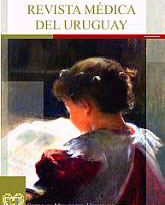Pialsinangiosis como tratamiento en la enfermedad de moyamoya en niños
Resumen
La enfermedad de moyamoya es una afección cerebrovascular caracterizada por la oclusión crónica y progresiva de ambas carótidas internas intracraneanas y los vasos proximales del polígono de Willis, que determina clínicamente accidentes cerebrovasculares isquémicos recurrentes.
Se resumen y actualizan los conceptos de esta enfermedad y se presenta el caso clínico de un paciente pediátrico sometido al procedimiento quirúrgico de pialsinangiosis, con una evolución clínica satisfactoria y con evidencia imagenológica de desarrollo de circulación colateral hacia la zona del procedimiento quirúrgico.
Citas
(2) Suzuki J, Takaku A. Cerebrovascular "moyamoya" disease: A disease showing abnormal net-like vessels in base of brain. Arch Neurol 1969; 20: 288-99.
(3) Kudo T, Fukuta S. Spontaneous occlusion of the circle of Willis. Shinkei-shimpo 1976; 20: 750-7.
(4) Kitahara T, Okumura K. Genetic and immunologic analysis and moyamoya disease. J Neurol Neurosurg Psychiatry 1982; 45: 1048-50.
(5) Okuno T, Prensky A, Gado M. The moyamoya syndrome association with irradiation of an optic glioma in children: Report of two cases and review of the literature. Pediatr Neurol 1985; 1: 311-6.
(6) Bitzer M, Topka H. Progressive cerebral occlusive disease after radiation therapy. Stroke 1995; 26: 131-6.
(7) Gordon N, Isler W. Childhood moyamoya disease. Dev Med Child Neurol 1989; 31: 103-7.
(8) Hoshimaru M, Takahashi A, Kihuchi H, Nagata I, Masakazo H. Possible roles of bFGF in the pathogenesis of moyamoya disease: an immunohistochemical study. J Neurosurg 1991; 75: 267-70.
(9) Yoshimoto T, Koukin K, Takahashi A, Abe A. Angiogenic factors in moyamoya disease. Stroke 1996; 27: 2160-5.
(10) Yonekawa Y, Goto Y. Moyamoya disease: diagnosis, treatment, and recent achievements. Stroke 1992; 23: 722.
(11) Choux M, Di Rocco C, Hockley A, Walker M. Pediatric neurosurgery. London: Churchill-Livingstone, 1999: 705 p.
(12) Mohr JP, Choi DW, Grotta JC, Weir B, Wolf P, eds. Stroke: pathophysiology, diagnosis and management. 4ed. London: Churchill-Livingstone, 2004: 603 p.
(13) Han D, Nam D, Oh AC. Moyamoya disease in adults: characteristics of clinical presentation and outcome after encephalo-duro-arterio-synangiosis. Clin Neurol Neurosurg 1997; 99(Suppl 2): S196-S201.
(14) Sirio E, Scavone C, San Julián E, Berta S, Delfino A. Enfermedad de Moya Moya: presentación hemorrágica. Arch Inst Neurol 2003; 6: 63-6.
(15) Ohaegbulam C, Magge S, Scott RM. Moyamoya Syndrome. In: McClone D, ed. Pediatric neurosurgery. Philadelphia: W.B.Saunders, 2001: 1077-92.
(16) Mohr JP, Choi DW, Grotta JC, Weir B, Wolf P, eds. Stroke: pathophysiology, diagnosis and management. 4ed. London: Churchill-Livingstone, 2004: 603 p.
(17) Fukui M. Guidelines for the diagnosis and treatment of spontaneous occlusion of the circle of Willis ("moyamoya" disease). Research Commitee on Spontaneous Occlusion of the Circle of Willis (Moyamoya Disease) of the Ministry of Health and Welfare, Japan. Clin Neurol Neurosurg 1997; 99(Suppl 2): S238-40.
(18) Ohaegbulam C, Magge S, Scott RM. Moyamoya Syndrome. In: McClone D, ed. Pediatric neurosurgery. Philadelphia: W.B.Saunders, 2001: 1077-92.
(19) Krayenbuhl H. The moyamoya syndrome and the neurosurgeon. Surg Neurol 1975; 4: 353-60.
(20) Henschen C. [Surgical revascularization of cerebral injury of circulatory origin by means of stratification of pedunculated muscle flaps.] Langenbecks Arch Klin Chir Ver Dtsch Z Chir. 1950; 264: 392-401.
(21) Karasawa J, Kikuchi H, Kawamura J, Sakai T. Intracranial transplantation of the omentum for cerebrovascular moyamoya disease: a two year follow-up study. Surg Neurol 1980; 14: 444-9.
(22) Matsushima Y, Fukai N, Tanaka K, Tsuruoka S, Inaba Y, Aoyagi M, et al. A new surgical treatment of moyamoya disease in children: a preliminary report. Surg Neurol 1981; 15: 313-20.
(23) Matsushima Y, Inoue T, Suzuki S, Fujii K, Fukui M, Hasuo K. Surgical treatment of moyamoya disease in pediatric patients–comparison between the results of indirect and direct revascularization procedures. Neurosurgery 1992; 31: 401-5.
(24) Spagnuolo E, et al. Revascularización encefálica indirecta (encéfalo-duro-arterio-mio-sinangiosis) en la enfermedad de moyamoya. Arch Inst Neurol 2002; 5: 73-7.
(25) Adelson P, Scott RM. Pial sinangiosis for moyamoya syndrome in children. Pediatr Neurosurg 1995; 23: 26-33.
(26) Scott RM. Pial sinangiosis. In: McClone D, ed. Pediatric neurosurgery. Philadelphia: W.B.Saunders, 2001: 1093-6.
(27) Choux M, Di Rocco C, Hockley A, Walker M. Pediatric neurosurgery. London: Churchill-Livingstone, 1999: 709-771.














